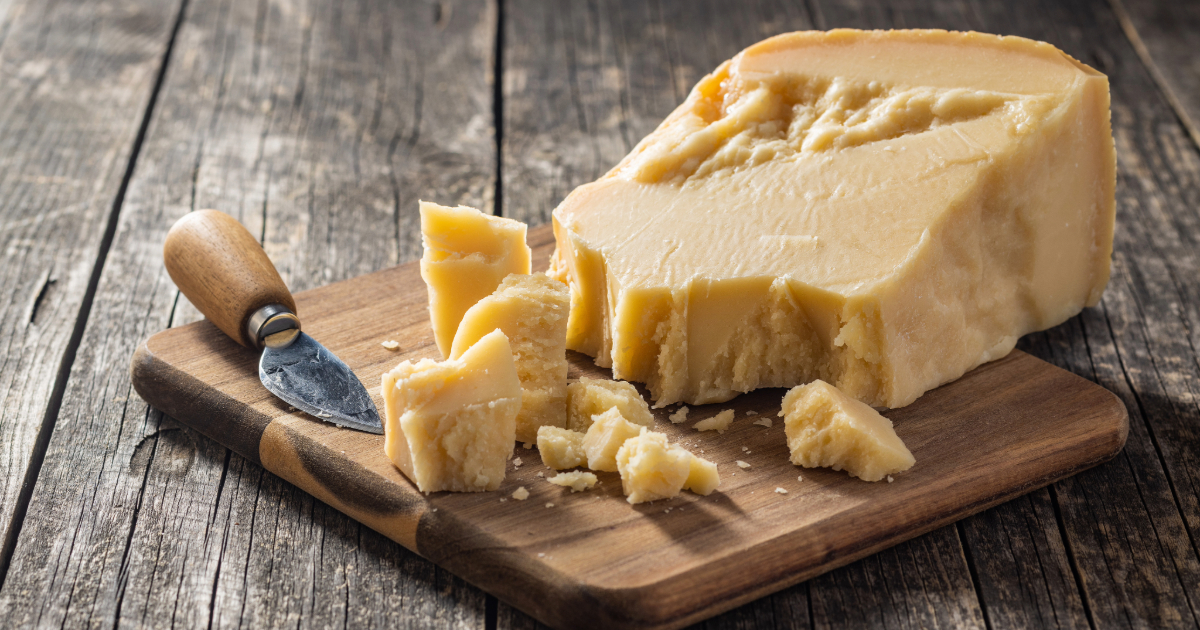You likely enjoy Italian food partly for the delicious cheese.
Two popular options are the sharp, salty parmesan cheese and pecorino romano cheese. But what exactly sets them apart?

While they look similar and have some overlapping uses, parmesan and pecorino are made differently.
How Parmesan Cheese Is Made
Parmesan originated in Italy. To be called Parmigiano-Reggiano, parmesan must be produced in certain approved provinces using traditional techniques.
Parmesan comes from cow's milk. It's made into large wheels and aged for over one year, sometimes up to three years. This long aging gives it a characteristic nutty, salty flavor.
True Parmigiano-Reggiano has a hard texture and pale yellow color. It can be grated or eaten in slices or shards. The extensive aging process concentrates the flavor so a little parmesan packs a punch.
Key Takeaway: Parmesan cheese is made from cow's milk and aged over one year, giving it a salty, nutty flavor.
How Pecorino Romano Is Made
Pecorino refers to Italian cheeses made from sheep's milk. Pecorino romano is the best known variety. It's primarily produced in Sardinia and Lazio.
Pecorino romano comes from sheep's milk, making it different from cow's milk parmesan. It's aged for at least 5 months and up to 8 months.
Compared to parmesan, pecorino romano has a sharper, saltier, more pungent taste. It also has a distinctive tang and herbal flavor from the sheep's milk. Pecorino romano is white in color and doesn't melt easily.
Key Takeaway: Pecorino romano is a sheep's milk cheese with a sharper, saltier bite compared to parmesan.
Parmesan vs Pecorino: Flavor and Uses
While parmesan and pecorino romano can both be eaten plain or grated onto foods, their differing strengths make certain uses better suited for each cheese.
Parmesan Flavor and Best Uses
Milder parmesan works well:
- Grated on pasta, risottos
- In baked pasta dishes like lasagna
- Topping vegetables, salads, eggs
- On its own with cured meats or fruit
Due to its subtle nuttiness, parmesan blends seamlessly without overpowering. It adds a savory pop that enhances many dishes.
Pecorino Romano Flavor and Best Uses
Pecorino romano's boldness stands out when:
- Paired with strong flavors like red pepper flakes and black pepper in cacio e pepe
- Served with honey or jam to contrast the saltiness
- Used sparingly in place of parmesan to add a kick
Too much pecorino romano can overwhelm other ingredients. But in the right amounts, its sharpness shines through.
Key Takeaway: Parmesan has a more subtle flavor good for topping many dishes, while pecorino romano is bold and best used judiciously.
Can You Substitute One for the Other?
You can swap small amounts of pecorino for parmesan and vice versa. But expect a different flavor profile due to their differences.
Some tips when substituting:
- Use less of the stronger pecorino romano
- Add pecorino romano slowly until the flavor pops but doesn't overwhelm
- Grate parmesan more finely if using in a pecorino-based dish to distribute its flavor
Their tastes vary too much to directly replace one for one. But with care you can successfully use them interchangeably.
Key Takeaway: You can substitute parmesan and pecorino romano by adjusting amounts based on their difference in strength.
How to Store Parmesan and Pecorino
Properly stored, both parmesan and pecorino cheeses keep fresh for months. Follow these storage tips:
- Buy smaller chunks and use quickly
- Wrap tightly in parchment paper and plastic wrap/foil
- Store in fridge vegetable crisper drawer
- Check periodically for mold or off smells
| Lasts Best When Stored | Parmesan | Pecorino Romano |
|---|---|---|
| Room temperature | 1-2 weeks | 1 week |
| Fridge | 6+ months | 6+ months |
| Freezer | 6 months | 6 months |
With their low moisture and dense texture, hard Italian cheeses resist mold growth. But humidity and air cause them to dry out or spoil faster. Proper storage keeps both parmesan and pecorino fresh for enjoying later.
FAQs
Is there lactose in Parmesan or pecorino romano?
No, neither cheese contains lactose due to the aging process. Even those sensitive to dairy can often enjoy small amounts.
What's the difference between Parmesan, Parmigiano-Reggiano, and pecorino romano?
- Parmesan is the generic English name for a style of cheese. American-made versions mimic Italian parmesan.
- Parmigiano-Reggiano refers to real parmesan meeting strict production requirements in certain Italian provinces.
- Pecorino romano is a sheep's milk cheese with protected Italian branding.
Can you freeze Parmesan or pecorino romano cheese?
Yes, both cheeses can be frozen for up to 6 months. Make sure to double wrap the cheese to prevent freezer burn. Thaw slowly in the fridge before using.
What wine pairs well with Parmesan or pecorino?
- For Parmesan, go with red wines like Sangiovese or Barbaresco
- For pecorino's sharper bite, try pairing with crisp white wines like Pinot Grigio
The intensities match well without overpowering each other.
Conclusion
While parmesan and pecorino romano may seem interchangeable, understanding their differences helps utilize each cheese's unique traits.
Parmesan offers subtle nuttiness good for topping many dishes, while pecorino romano is bold and works best combined judiciously with other strong flavors. Both make wonderful additions to Italian cuisine and can fill in for each other when needed.

